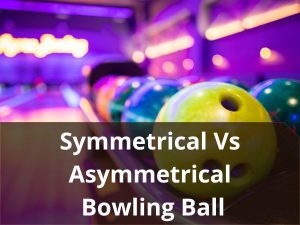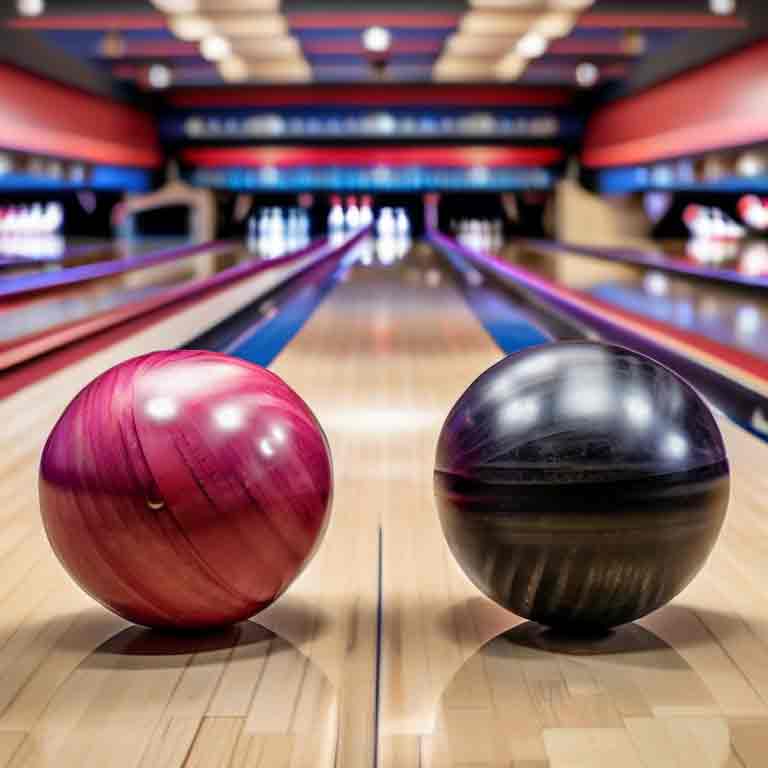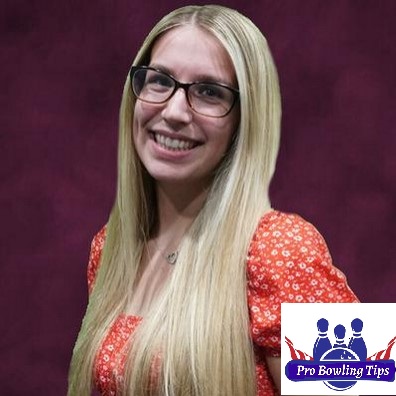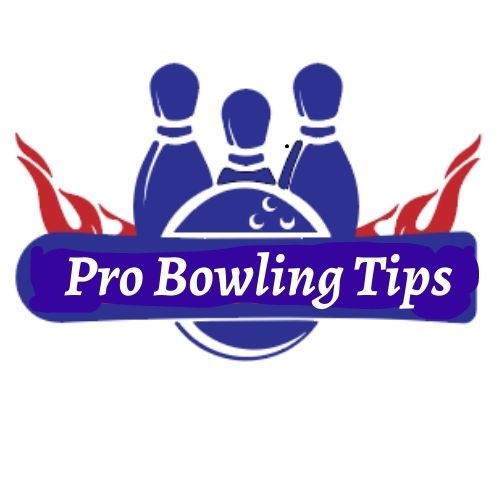Symmetrical Vs. Asymmetrical Bowling Ball! When bowlers debate on symmetrical vs asymmetrical bowling balls, what do you think they mean by that? This is where the science of bowling kicks in. Does it have anything to do with its spherical shape? Do asymmetrical bowling balls indicate they are not round enough? Absolutely, not! Bowling balls are geometrically round with precision.
They cannot be any other shapes but round. So where do this symmetry and asymmetry come from? Well, when we talk about this, we mean the weight blocks and the cores. Not the coverstock, not the outer shape, just the cores. Based on the core type, bowling balls perform notably differently. Let me enlighten you with some important facts. How does that sound?

What is a Symmetrical bowling ball?
- Core Design: Symmetrical balls have a core with a uniform, balanced design. The weight distribution is even, which results in a consistent and predictable motion.
- Motion on the Lane: They tend to have a smoother, more controlled roll and a gentle hook. This makes them more predictable in their behavior as they travel down the lane.
- Suitability: Ideal for beginners or bowlers who prefer a straighter line to the pins. They are also great for conditions where a strong hook is not advantageous, or for bowlers who need more control and less backend reaction.
- Versatility: Symmetrical balls are versatile and can be effective on a variety of lane conditions, but they might not be as effective on heavily oiled lanes as an asymmetrical ball.
You can guess from the name what a symmetrical bowling ball is. Nonetheless, let me elaborate. Simply put, bowling balls with symmetrical cores are called symmetrical bowling balls. To define it in a more complex and understanding way— symmetrical balls do not have more than 5% of the difference in the value of the Y and Z axes of the RG.
Symmetrical bowling balls are best known for their smooth and controllable rolls. The ball motion is quite predictable which makes you understand the ball better and where will it go and of course, how it will hit the pockets. When a symmetrical bowling ball exit an oil pattern and encounters friction, it still goes smooth.
Structurally, a symmetrical bowling ball is completely identical from one side of the object to the other side. If you cut open a bowling ball (don’t do that actually, haha) exactly from the middle, one side is going to look exactly like the other. However, vertically and horizontally they may not be equal.
How do you layout a symmetrical bowling ball?
As of August 1, 2020, you will no longer have to worry about CG placement as it won’t impact your performance. Because of this new rule, you have more flexibility in drilling your bowling balls that have symmetrical cores inside.
First, measure the pin to PAP distance. After that, take the VAL angle to create the shape of the ball motion. Now, the fun part begins. Place your CG anywhere you want! It really doesn’t matter! Just adjust your ball surface to get your preferred breakpoint distance.
What is an Asymmetrical bowling ball?
- Core Design: These balls have an irregularly shaped core, which creates an inherent imbalance. This design allows for a more dynamic internal movement within the ball.
- Motion on the Lane: They are known for their aggressive hook potential, especially in the backend of the lane. This angular motion can be particularly useful for knocking down pins at steeper angles.
- Suitability: Better suited for experienced bowlers who have mastered control and are looking for a ball to create a more aggressive hook. They are particularly useful in heavy oil conditions where a stronger hook is needed to reach the pins effectively.
- Lane Conditions: Asymmetrical balls are generally preferred on oily lanes or when a bowler wants to create a significant angle into the pocket. They offer more options for playing deeper lines and sharper angles.
Here, the name also suggests the kind of core an asymmetrical bowling ball has. Yes, you guessed it right. The core is asymmetric. If you cut down an asymmetrical bowling ball from the middle, one side is going to be different from the other.
The bowling ball developers noticed that they could get different types of reactions when they change the structure of the core from one side to another. They found out that an asymmetrical-cored ball creates a completely different ball reaction that is helpful for many bowlers.
For a complex definition— asymmetrical balls have more than 5% of the difference in the value of the Y and Z axes of the RG. These balls are best for speed-dominant bowlers who want satisfactory ball performance. Low rev high-speed bowlers love asymmetrical balls the best! The ball motion is much sharper and pronounced when asymmetrical balls encounter friction.

How do you layout an asymmetrical bowling ball?
So how much flexibility do you get when it comes to drilling your asymmetrical balls? Well, asymmetrical bowling balls have 3 axes that have different RG values. Because of these additional variables, you can get your ball drilled in many layouts. However, you cannot do it any way you want. There are a few certain layout possibilities that can be achieved. Depending on what layout you select, the extra RG plane that asymmetrical bowling balls have affects ball motion and its performance on the lane.
The most important factor in layouts for asymmetrical balls is the location of the lower locator pin in relation to the bowler’s access point. If you want to get the smoothest and heaviest midlane continuation roll, you need to put the locator’s pin right in the bowler’s thumb hole. The PSA in the thumb hole is going to give you a reaction similar to what you get with a symmetrical ball (with the locator pin in it).
An asymmetrical bowling ball will be stronger PSA is going to read the pattern and continue harder. You can move your PSA a bit to the side of the thumb hole if you want a firmer and harder ball reaction and breakpoint. That will allow you to have plenty of layout options and choose the one that fits you best.
Choosing Between the Two
- Skill Level: Beginners or those seeking control might prefer symmetrical balls, while experienced bowlers looking for a dynamic hook might opt for asymmetrical balls.
- Lane Conditions: Consider the typical lane conditions you bowl on. Heavier oil conditions might warrant an asymmetrical ball, while drier lanes could be better suited to symmetrical balls.
- Personal Style: Your bowling style, including speed and rev rate, will also influence the best choice for you.
In summary, while symmetrical balls offer control and predictability, asymmetrical balls provide dynamic movement and a more aggressive hook potential. The right choice depends on what you need in your game and the conditions you typically face.
How do you know if a bowling ball is symmetrical or asymmetrical?
Both symmetrical and asymmetrical balls look the same from the outside. Of course, they are balls. The difference is created because of what goes on the inside. In a symmetrical bowling ball, the core is the same on both sides. This means that if you could bust open a bowling ball from the middle, you would see an equally divided core on both sides.
But does that mean it is the same around all the axes? Just because a symmetrical ball is the same around one axis, doesn’t mean it will have the same shape of the core around another. So, yeah, vertically and horizontally the core may not be equal. But that still makes it a symmetrical ball. You can find only a point of symmetry called the pin which is often pointed out with a marking. When you get your bowling ball drilled the mark helps to determine the right layout and make the best out of your symmetrical bowling ball.
If you slice open your asymmetrical bowling ball from the middle, do you think will you see the same scenario? Absolutely, not! The core will be in different shapes and sizes on both sides. Besides, cutting open, is there any other way you can tell which is which?
The best way to determine if a bowling ball has a symmetrical core or not is by throwing it down the lane and observing its reaction and motion. If that ball has a sharp, angular breakpoint and an aggressive move toward the pins, chances are- that is an asymmetrical bowling ball. If the ball motion is much smoother without any further aggression, and the breakpoint has a pronounced shape, then it is a symmetrical bowling ball.
Another simple way to tell whether your bowling ball is symmetrical or not is by reading the ball specs. If you notice only 2 variables of the core specs (RG and Differential), then it is a symmetrical ball. If you see 3 different core specs (RG, differential, and intermediate differential), it is an asymmetrical bowling ball.
Which bowling ball do you need: Symmetrical or asymmetrical?
If you’re a rev dominant bowler instead of a speed dominant bowler, a symmetrical bowling ball will suit you better. Symmetrical bowling balls are perfect for those who attempt to throw their bowling ball to increase their rev rate. Players with low rev rate and low speed can really get benefited from using a symmetrical bowling ball.
Then comes the bowlers who have a lower rev rate but a lot of speeds in their bowling ball. They can truly benefit from using an asymmetrical bowling ball. Why? Because these balls are very friendly for speed-dominant bowlers. It is also important you be sure that you can handle a bowling ball that is hard to control. If you think you can take the heat and utilize the low rev rate, asymmetrical balls will be your best choice. If you, as a high-level bowler, struggle with putting a great number of revolutions on your shots, just go for asymmetrical bowling balls.
FAQs Of Symmetrical Vs. Asymmetrical Bowling Ball!
What is the main difference between symmetrical and asymmetrical bowling balls?
The primary difference lies in the core design. Symmetrical bowling balls have a core with a uniform shape, leading to a more balanced and predictable roll. Asymmetrical bowling balls have a core with an irregular shape, which creates an imbalance, leading to a more angular motion and a potentially more aggressive hook.
Which is better for beginners, symmetrical or asymmetrical bowling balls?
Symmetrical bowling balls are generally better for beginners. Their balanced nature offers a more predictable and controlled motion, making it easier for new bowlers to develop consistency in their throws.
Do asymmetrical bowling balls hook more than symmetrical ones?
Yes, typically, asymmetrical bowling balls have the potential to hook more aggressively than symmetrical ones. The imbalance in the core allows these balls to create more angular motion, especially in the backend of the lane. However, the bowler’s technique and lane conditions also play a significant role in the ball’s hook.
Can symmetrical bowling balls be used on oily lanes?
Yes, symmetrical bowling balls can be used on oily lanes, but their effectiveness depends on the coverstock and the bowler’s style. Generally, on oily lanes, balls with a stronger coverstock and higher weight block dynamics are preferred. Symmetrical balls with the right surface preparation can perform well on oily conditions.
How do I choose between a symmetrical and an asymmetrical bowling ball?
The choice depends on your bowling style and what you want to achieve with your ball motion. If you prefer a more controlled and straighter path, a symmetrical ball is a good choice. If you are an experienced bowler looking for a ball that can create a more dynamic hook and angular motion, then an asymmetrical ball would be suitable. Also, consider the lane conditions you frequently bowl on, as this can influence the type of ball that will perform best for you.
Conclusion
Congratulations if you got this far! That’s all I gotta say about symmetrical vs asymmetrical bowling balls. Now you know all the necessary information regarding this topic. Despite the kind of ball you choose for yourself, make sure it is as effective as a bowling ball can get. Leave a comment down below if you have any more questions on your mind and I will try to prove you with the proper guidance you need. Good luck, mates!

Passionate Bowler and Bowling Enthusiast
Jess Pinelli is a dedicated bowling enthusiast with a deep love for the sport that spans over 6 years. With numerous strikes, spares, and a few gutter balls under hes belt, he has honed his skills on lanes across the country. Pinelli’s journey in the world of bowling has been a remarkable one, from casual weekend games with friends to competitive league play and even a few local tournaments.
Driven by her passion for the game, Pinelli decided to channel her expertise and knowledge into the digital realm, becoming a prolific author on this bowling website. She’s your go-to source for everything bowling-related, from mastering the perfect hook to choosing the right bowling ball and even navigating the world of bowling etiquette.
When she’s not busy writing informative articles or reviewing the latest bowling gear, you’ll likely find Pinellis at her favorite local bowling alley, helping newcomers improve their game or enjoying some friendly competition with fellow bowlers. She firmly believes that bowling is not just a game but a community, and she’s committed to fostering that sense of camaraderie both online and offline.



